
views
Making a Times Table
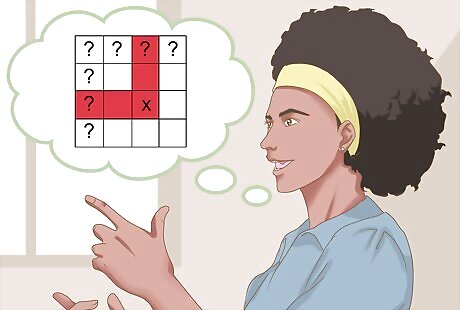
Understand how to read a times table. A times table shows the products of sequential factors. Each column is labeled with one factor, and each row is labeled with another factor. The cell where the row and column meet gives you the product of the two factors.

Determine how many factors you need in your times table. The standard times table is for factors 1-12, but your teacher may only require you to memorize a table for factors 1-10, depending on what grade you are in.

Use a ruler to create 12 rows and 12 columns. You can also find a blank table online and print it, or use graph paper. It’s best to keep your table very neat, so that you don’t confuse factors. When you make your table, be sure to keep room to the top and left of it so that you can label your rows and columns.
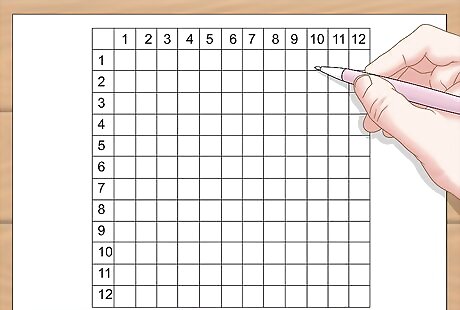
Label the columns and rows 1-12. The column to the left should be labeled “1,” and the other columns labeled in order up to 12. The top row should also be labeled “1,” and the other rows labeled in order down to 12.
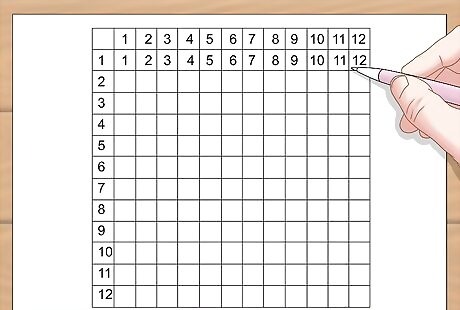
Fill in the products for each multiplication sentence with a factor of 1. Since any number times 1 equals that number, you can quickly fill in the first row and first column of your times table, since these will all equal the number being multiplied by 1. For example, in the top row, you would fill in 1, 2, 3, 4, 5, 6, 7, 8, 9, 10, 11, and 12, since 1 × 1 = 1 {\displaystyle 1\times 1=1} 1\times 1=1, 2 × 1 = 2 {\displaystyle 2\times 1=2} 2\times 1=2, 3 × 1 = 3 {\displaystyle 3\times 1=3} 3\times 1=3, etc. The first column follows the same pattern, since it shows 1 × 1 = 1 {\displaystyle 1\times 1=1} 1\times 1=1, 1 × 2 = 2 {\displaystyle 1\times 2=2} 1\times 2=2, 1 × 3 = 3 {\displaystyle 1\times 3=3} 1\times 3=3, etc.

Fill in the rest of the second row. The second row represents 2 × x {\displaystyle 2\times x} 2\times x, where x {\displaystyle x} x equals each factor you are multiplying by 2, from 2-12. For example, 2 × 2 = 4 {\displaystyle 2\times 2=4} 2\times 2=4, 2 × 3 = 6 {\displaystyle 2\times 3=6} 2\times 3=6, 2 × 4 = 8 {\displaystyle 2\times 4=8} 2\times 4=8, etc.

Fill in the remaining rows. In each row, you are multiplying that row’s factor by each factor represented in the columns. A quick way to fill in each row using mental math is to add that row’s factor to each product. For example, the numbers in the third row will be 3, 6, 9, 12, 15, 18, 21, 24, 27, 30, 33, 36. The numbers in the fourth row will be 4, 8, 12, 16, 20, 24, 28, 32, 36, 40, 44, 48. Note that for the third row, which represents the factor 3, you simply add 3 to each product to get the next product. For the fourth row, which represents the factor 4, you add 4 to each product to get the next product.

Check your table. You can verify all of your numbers are correct by using a calculator. You can also check your table against one in your math textbook or online.
Making a Multiplication Chart
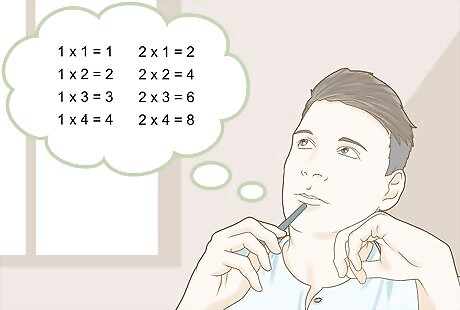
Understand how to read this type of chart. This type of chart is made up of separate tables for each factor. Each table shows the sequence of products when you multiply this factor by other numbers. For example, this type of chart has a table showing all the products of the factor 1, another table for all the products of the factor 2, another table for all the products of the factor 3, etc. Unlike a times table, this type of chart shows the number sentences for each factor.

Determine how many factors you need in your chart. The standard multiplication chart is for factors 1-12, but you might need to create a chart with fewer or more factors, depending on your teacher’s requirements.
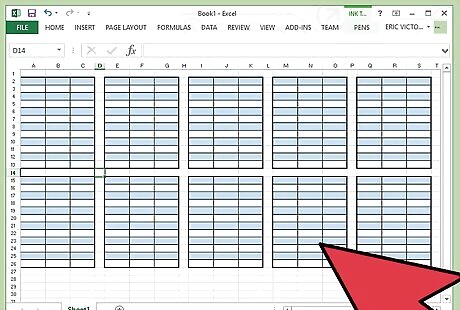
Create 12 tables. Each table should have 12 rows and 3 columns. All 12 tables should fit on one piece of paper. Make sure your table is neat by using ruler to create the lines. It is also best to use graph paper, or you can make your chart in a spreadsheet program, such as Microsoft Excel.
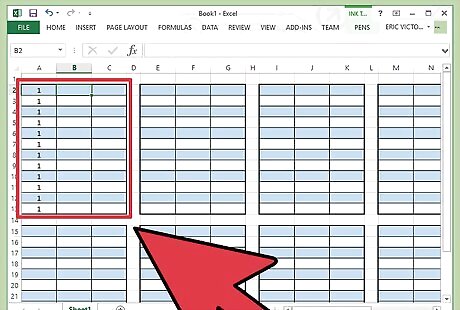
Fill in the first column of the first table. Each cell in this column will have a number 1, since this is the table for the factor 1.
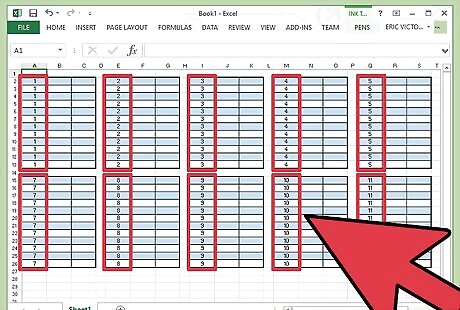
Fill in the first column of the remaining tables. In the first column of each table, you will simply repeat whatever factor that table represents. So the second table should have a 2 in each cell, the third table should have a 3 in each cell, etc.
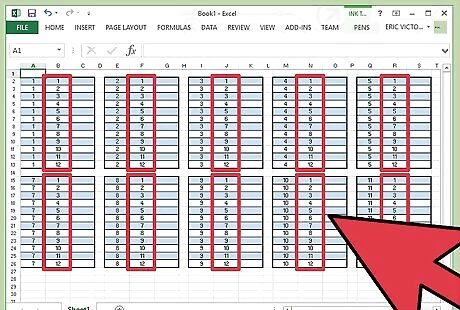
Fill in the second column of each table. In the second column you will write each factor, from 1-12. This column will be the same in each table.

Fill in the multiplication and equals signs for each multiplication sentence. The multiplication sign will come between the two factors. The equals sign will come after the second factor. For example, in the first table, you should have: 1 × 1 = {\displaystyle 1\times 1=} 1\times 1= 1 × 2 = {\displaystyle 1\times 2=} 1\times 2= 1 × 3 = {\displaystyle 1\times 3=} 1\times 3= 1 × 4 = {\displaystyle 1\times 4=} 1\times 4= 1 × 5 = {\displaystyle 1\times 5=} 1\times 5= 1 × 6 = {\displaystyle 1\times 6=} 1\times 6=etc.

Fill in the final column of each table. This column will show the product of each multiplication sentence. To fill in this column quickly, simply add whatever factor that table represents to each product. For example, the products for the 5s table are 5, 10, 15, 20, 25, 10, 35, 40, 45, 50, 55, 60. Notice that for each new product, you are adding 5 to the product that came before.
Using Your Chart or Table

Review it daily. To help you memorize the chart, aim for reviewing it for at least five minutes each day. Review the table by reading over it and by quizzing yourself. You can have someone else quiz you, or you can use an online program, such as the Math Trainer found at Math is Fun.
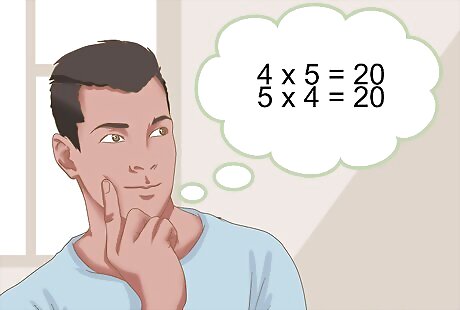
Look for patterns. Finding patterns in the numbers can help you better remember your times tables. Think about how the numbers relate to each other moving from left-to-right, up and down, or diagonally. Note that the order of the multiplication does not matter. For example, 4 × 5 = 20 {\displaystyle 4\times 5=20} 4\times 5=20 and 5 × 4 = 20 {\displaystyle 5\times 4=20} 5\times 4=20. Notice that when a factor is doubled, its product is doubled. For example, compare the fourth row of the times table with the eight row. Compare the fifth row with the tenth row. If you look at the times table for the factor 5, you should see that when you multiply 5 by an odd number, the product ends in 5, and when you multiply 5 by an even number, the product ends in a 0. Note that when you multiply any single-digit factor (1-9) by 11, the product has that digit in the ones and the tens place. For example, 4 × 11 = 44 {\displaystyle 4\times 11=44} 4\times 11=44 and 7 × 11 = 77 {\displaystyle 7\times 11=77} 7\times 11=77. The table for the factor 9 has many patterns. When you add the digits of any product, their sum equals 9. Also, as you move up the times table, the digit in the ones place goes down by 1.

Memorize it in chunks. If you try to memorize the entire times table at the same time, you’ll have a difficult time retaining all of the numbers. It’s better to divide the table up into several sections and study each section until you have it memorized. For example, you might first memorize your multiplication facts from 1 x 1 {\displaystyle 1x1} 1x1 down to 6 x 6 {\displaystyle 6x6} 6x6 (the top left corner of the chart). Then you can memorize your facts from 1 x 7 {\displaystyle 1x7} 1x7 to 6 x 12 {\displaystyle 6x12} 6x12 (the top right corner of the chart. Then you can memorize your facts from 7 x 1 {\displaystyle 7x1} 7x1 to 12 x 6 {\displaystyle 12x6} 12x6 (the bottom left corner). Finally, you can memorize your facts from 7 x 7 {\displaystyle 7x7} 7x7 to 12 x 12 {\displaystyle 12x12} 12x12 (the bottom right corner).

Make a new chart from memory. The best way to see how much you’ve memorized is to create a new chart without using a calculator or any other help. You should also try to fill in products automatically, without doing any mental math. Set a time limit, such as 3 minutes, and see whether you can fill in the entire chart in that amount of time. Each time, see if you can fill in the chart faster. When you practice making a new chart, fill in the easy calculations first. Skip any product that doesn’t come to you right away. When the time limit is up, you know that you need to work on memorizing the products you could not fill in.




















Comments
0 comment